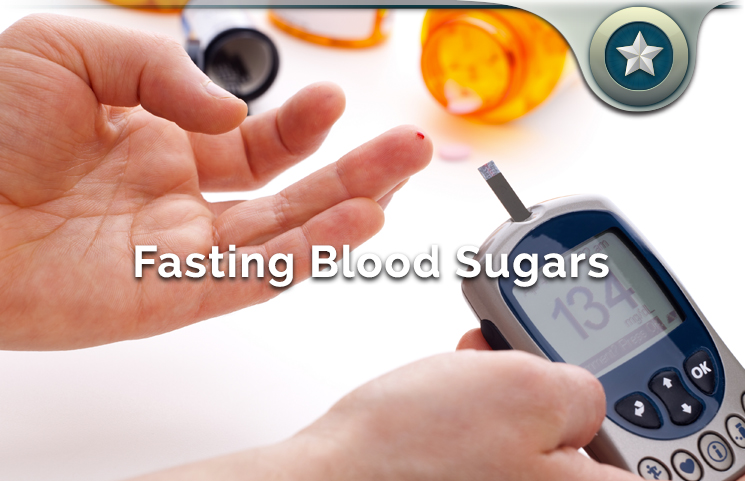Fasting blood sugar is used to determine the levels of blood sugar which tend to peak after meals and decline after that. High fasting blood sugar may indicate the presence of diabetes or insulin resistance while diabetes drugs could cause a low fasting blood sugar.
What Are Fasting Blood Sugar Levels?
The levels of blood sugar tend to peak one hour after eating. Diet determines the rise in the blood sugar level and the timing. Large meals will lead to cause a more substantial rise in blood sugar levels. Foods with high-sugar carbohydrates such as bread and sweetened snacks may cause a significant increase in blood sugar concentration.
In a healthy person, the pancreas releases insulin whenever the blood sugar level rises. Insulin helps lower the blood sugar concentration to normal levels. However, individuals who are diagnosed with diabetes may have problems with insulin.
Those having type 1 diabetes do not secrete insulin because the beta cells which are responsible for the production of insulin get destroyed. Individuals diagnosed with type 2 diabetes do not respond well to insulin produced by the beta cells. As a result, there will be a rise in blood sugar level in both type 1 and type 2 diabetics.
Three major factors affect the fasting blood sugar level include the diet, the size of the previous meal, and the ability of the body to produce and respond to insulin. The blood sugar levels in between meals provide an idea on how your body manages sugar.
High levels of fasting blood sugar may indicate the inability of the body to secrete enough insulin or its failure to respond to insulin. When the blood sugar concentration is abnormally small, diabetes drugs may be lowering the sugar too much.

How Is Fasting Blood Sugar Tested?
The two primary tests for fasting blood sugar include the traditional blood sugar test and the new method which is known as glycosylated hemoglobin (HbA1c). The new method is used to determine how the body manages blood sugar levels over a period.
The HbA1c method is preferred because it does not fluctuate and can provide a good indication of an individual's average sugar levels for several months. The test procedure saves people who take diabetes drugs and whose blood sugar concentration is well managed from undergoing daily monitoring.
However, most doctors prefer putting their patients through the traditional test method and have them check the blood sugar levels on a daily basis. Most health providers ask patients to measure their blood sugar levels after waking up, before eating or drinking anything, and before bedtime.
The most appropriate time to test the blood sugar level is determined by several factors such as the treatment goals and the type of diabetes. For instance, most diabetic individuals do not need to check their blood sugar levels in between meals unless they are on diabetes medications that may lower the blood sugar. Others may check their sugar levels between meals if they have a feeling that their blood sugar levels are low.
Individuals with type 1 diabetes may have to test multiple times during the day since they do not produce insulin.
The following should be observed when testing fasting blood sugar:
- The test strip and the glucose meter should be prepared to receive the sample.
- The testing area should be well cleaned using an alcohol swab. The most preferred testing area is the side of a fingertip.
- The testing area should be pricked then squeezed to increase the blood flow. A drop of blood should then be squeezed onto the test strip.
- After collecting the sample, the test strip should be placed into the glucose meter. One should then record the time, the blood sugar reading, and the recent food intake in a log.
The Target Levels
The following are the target blood sugar numbers. The numbers are provided in milligrams per deciliter (mg/dL):
- Morning testing before eating or drinking anything, also known as fasting, is 70-100 mg/dL for people without diabetes and 70-130 mg/dL for people with diabetes.
- Two hours after a meal, the target blood sugar levels are 140 mg/dL for people without diabetes and 180 mg/dL for individuals diagnosed with diabetes.
How to Maintain A Healthy Fasting Blood Sugar
It is advisable to follow a healthy diet to prevent the fasting blood sugar levels from rising.
Some of the strategies that can be used to keep fasting blood sugar at a healthy level include:
- Lowering the daily intake of sodium.
- Avoiding the consumption of high-caloric foods, low-nutrient white bread, and pasta.
- Reducing the consumption of sweetened snacks.
- Increasing the intake of foods that are high in fiber to help the body lower the blood sugar concentration.
- Consuming foods that are high in proteins to help support the feelings of fullness.
- Eating non-starchy vegetables as they are less likely to increase the levels of blood sugar.
Individuals with diabetes who are on diabetes medications should adhere to the same diet to avoid dangerous blood sugar dips. They also ought to take other proactive steps to prevent the blood sugar levels from dropping to dangerous levels.
The steps include:
- Eating regular meals.
- Avoiding the consumption of alcohol or limiting its use.
- Consulting their health care provider if diarrhea and vomiting make it difficult to control the blood sugar concentration.
Symptoms of Unhealthy Blood Sugar Levels
When the blood sugar concentration is too low, the patient is likely to experience the following symptoms:
- An irregular heart rhythm.
- Difficulty concentrating.
- The patient may feel sleepy or fatigued.
- Poor coordination and feelings of weakness.
Individuals with an abnormally high blood sugar concentration can present with the following symptoms:
- Headache.
- Blurred vision.
- Fatigue.
- Increased levels of hunger or thirst.
When Should You See A Doctor?
An individual should see a doctor when there is any significant change in the blood sugar patterns. Persons who have been diagnosed with diabetes and those who are at risk of diabetes should consult a healthcare provider if:
- The levels of blood sugar become unusually high or low.
- They develop new or worsening diabetic symptoms.
- They start or stop using a new medication.
- They experience an abnormal rise in blood pressure.
Fasting Blood Sugars Final Thoughts
Individuals with diabetes should undergo regular monitoring of the blood sugar levels. The treatment used could change over time. An appropriate treatment plan should be outlined using the information about diet and exercise.









